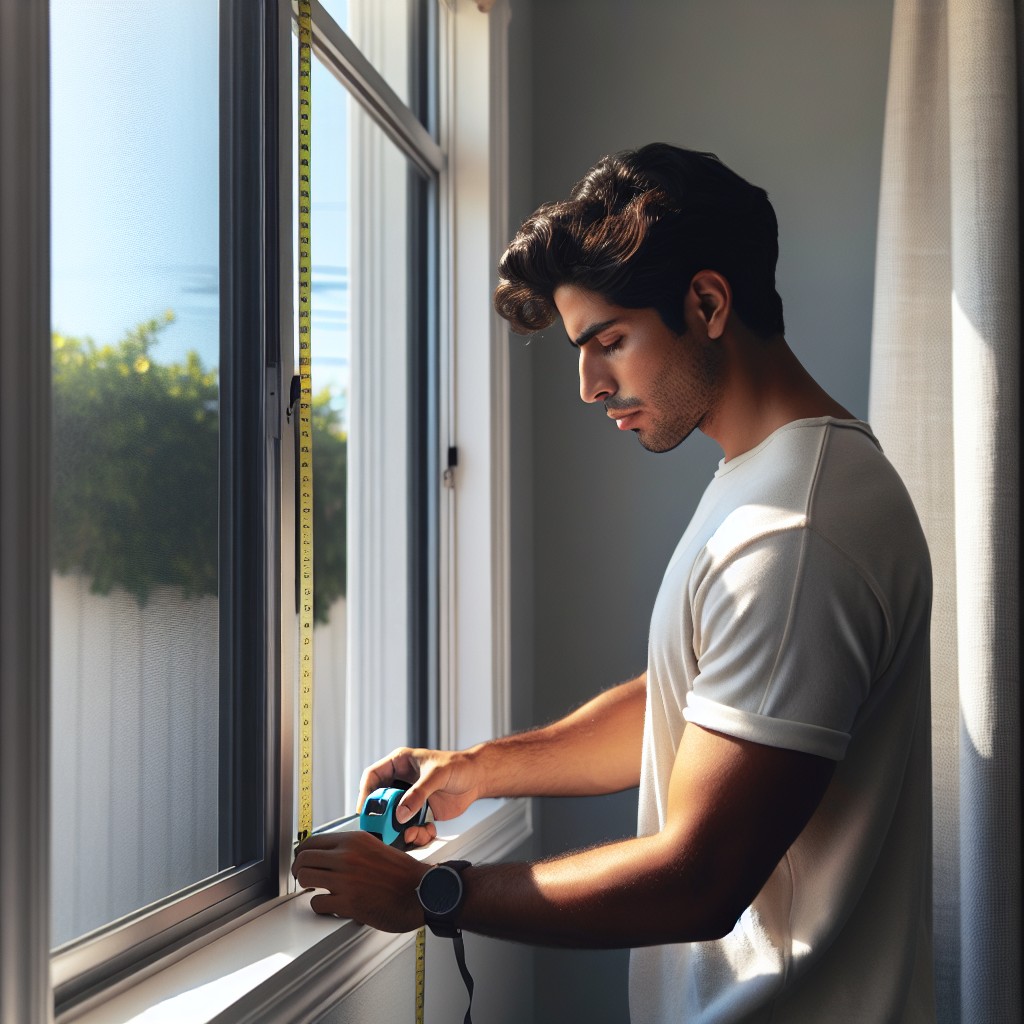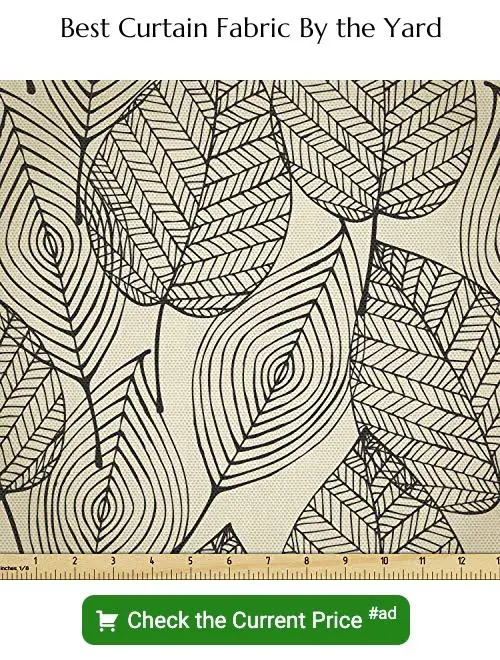Explore this in-depth guide because choosing the right amount of fabric for your curtains enhances the aesthetic appeal of your rooms and conserves resources.
Key takeaways:
- Use proper tools: metal measuring tape, yardstick, calculator, notepad.
- Measure window width and length carefully, considering desired fullness.
- Standard curtain lengths: 63, 84, 96, 108, 120 inches.
- Different curtain types require varying amounts of fabric.
- Consider pattern repeats and allowances for seams and hems.
Essential Tools for Measurement

To ensure accuracy when determining the amount of fabric needed for curtains, having the right tools is imperative. A metal measuring tape is preferred for its rigidity, which provides more accurate measurements than a flexible cloth tape. An extendable yardstick or long ruler can also assist with measuring large expanses, like the width of wider windows. Additionally, a notepad and pencil are essential for jotting down measurements and calculations. For those who plan to sew their own curtains, a fabric marker or tailor’s chalk can be useful for marking precise cutting lines directly on the fabric. Lastly, it’s advisable to keep a calculator handy to simplify the math involved in converting measurements and calculating fabric yardage.
How to Measure Your Window

Begin by taking the width of your window frame. Measure from one side to the other, inside the frame where the glass meets the wood or metal. Note this measurement as the ‘window width’. For the length, place the start of your tape measure at the top inside edge of the window, where the curtain rod will likely be placed. Extend the tape to where you’d like your curtains to end. This might be just below the windowsill, at the floor, or even pooling slightly on the floor for a more dramatic effect. This measurement is the ‘window length’.
Keep in mind that if you prefer your curtains to look full when closed, you might want to multiply the window width by a factor of 1.5 to 2.5 times for proper fullness. Don’t forget to take into account any additional length for desired hem or header styles, such as a ruffled top, which would require additional fabric length.
Jot down your measurements clearly and always double-check for accuracy before proceeding to purchase or cut any fabric. Accuracy at this stage is crucial for the final appearance of your curtains.
Standard Dimensions for Curtains
Understanding standard dimensions for curtains ensures that the fabric selected fits window sizes commonly found in homes. Typically, ready-made curtains come in lengths of 63, 84, 96, 108, and 120 inches. Widths are often found at 45, 54, or 60 inches per panel. While custom designs allow personalization, these standards provide a solid starting point for fabric calculations.
Here’s a rundown of what those dimensions look like in practice:
- Short window treatments, known as sill curtains, usually extend to the bottom of the window sill and are most often 63 inches long.
- For an apron look, which hangs slightly below the sill, add 3 to 6 inches to your length measurement.
- Standard lengths for floor-length curtains are 84 to 96 inches, starting from the curtain rod down.
- Luxurious, puddled drapes might need an additional 6 to 8 inches, creating a rich, billowing effect on the floor.
- As for width, aim for curtains that are 2 to 2.5 times the width of the window for proper fullness.
Remember these are guidelines to give curtains an appropriate look and feel, but the choice ultimately depends on personal preference and window specifications.
Types of Curtain and Ideal Fabric Dimensions
Different curtain types impact the amount of fabric required.
Pencil pleat curtains: These classic curtains require fabric that is two to two and a half times the width of the window for a full look.
Eyelet curtains: Known for their rings and contemporary style, they typically need fabric that is one and a half to two times the window width.
Tab top curtains: Featuring fabric loops, tab tops use fabric equal to the width of the window plus 30% for minimal fullness.
French pleat or pinch pleat curtains: These elegant options demand more fabric, often two and a half to three times the window width, to create deep pleats.
Goblet pleat curtains: Ideal for formal spaces, goblet pleat curtains also require two and a half to three times the window width to form the goblet shapes at the top.
Remember, the choice between a sleek or voluminous look will further refine these dimensions, and consider the curtain length, which can range from just below the windowsill to brushing the floor, or even a puddling effect which calls for extra length.
The Effect of Curtain Fullness
Curtain fullness refers to the extent to which fabric is gathered or pleated when the curtains are closed. The fullness amount can dramatically change both the aesthetic and functional aspects of your curtains. Here are some key points to understand:
- The standard fullness ratio for unlined curtains is typically 2:1. This means that for each foot of the curtain rod, two feet of fabric is used to achieve a pleasing look.
- Lined or heavyweight curtains may require less fullness, often around 1.5:1, to prevent them from becoming too bulky.
- Sheer curtains can benefit from a higher fullness ratio, sometimes 2.5:1 or even 3:1, in order to provide a rich, full appearance even when the fabric is transparent.
- The type of heading (eyelet, pencil pleat, etc.) will also influence the required fullness. For example, eyelet curtains generally need less fabric since the curtain hangs in wide, even folds.
When calculating fabric needs, fullness must be factored in to ensure that curtains look elegant and function properly, allowing for the correct level of privacy and light control.
Keep in mind, achieving the desired fullness is a balance between aesthetic preference and practicality, so considering the overall look and feel of the room is as important as working with precise measurements.
The Need for Seam and Hem Allowances
When calculating fabric needs, ensure you include extra material for seam and hem allowances. These small additions serve critical purposes:
- Allowance ensures you have enough fabric to fold over the raw edges to create a neat finish.
- Typically, a side seam allowance will be around 1 inch (2.5 cm) on each side, while a hem allowance at the bottom might range from 2 to 4 inches (5 to 10 cm), depending on the curtain length and style.
- An additional 3-4 inches (7.5-10 cm) at the top of the curtain fabric is required if creating a casing for a curtain rod or adding hooks.
- Don’t forget the header, which often requires an extra 3 inches (7.5 cm) above the rod pocket or eyelets to ensure the curtain hangs properly.
Remember, these measurements can vary based on the curtain style and the desired look, so adjust allowances accordingly. It’s better to have a bit too much fabric than not enough, as this gives you room for adjustments during the sewing process.
Calculating Fabric Amount for Pleated Curtains
Pleated curtains add elegance to a room, but require more fabric than non-pleated due to the fullness of the pleats. To calculate the necessary amount:
1. Determine the desired width of your finished curtains. Pleated styles typically require two to two and a half times the width of your window for adequate fullness.
2. Multiply your window width by the fullness factor you have chosen (usually between 2 and 2.5). This gives you the total curtain width needed.
3. Divide the total curtain width by the width of your chosen fabric. This will tell you how many fabric widths you need.
4. If you have more than one fabric width, remember to account for seaming allowances.
5. Calculate the length by measuring from the curtain rod to where you want your curtains to end. Add extra inches for hems at both the top and bottom.
Be mindful of any pattern repeats on your fabric, as this can influence the total amount needed to maintain pattern symmetry across the curtains. It may result in slightly more fabric to ensure that patterns line up properly when creating pleats.
Calculating Fabric Amount for Non-pleated Curtains
When estimating fabric for non-pleated curtains, such as rod pocket or tab top styles, width calculation is straightforward. Measure the width of your rod and multiply by 1.5 to 2 for a full look.
For floor-length curtains, measure from the rod to the floor and add 6-8 inches for hemming top and bottom. For sill-length, measure from the rod to the sill and add 4-6 inches.
Double the fabric width if making a pair. Always round fabric measurements up to the nearest whole number when purchasing to ensure you have enough material. Remember to account for horizontal seams if the fabric width is narrower than your curtain measurements.
Calculating Fabric Amount for Different Styles of Valances
When determining the amount of fabric needed for valances, bear in mind that their design and fullness significantly influence the required quantity. A straight valance requires fabric twice the window width to achieve a moderate gather, while a more opulent look demands three times the width.
For box-pleated valances, calculate the finished width of each pleat, then multiply by the number of pleats plus the space between them.
Remember to factor in the valance height; you will need additional length for a bottom hem and any casing or header at the top. Additional consideration is needed for patterns that must be matched across seams. With fabric width limitations, divide the valance width by the fabric width to gauge if joining pieces is necessary, leaving room for seam allowances. Always add a few extra inches to account for cutting errors or adjustments.
Keep in mind that more elaborate styles such as swags or tails involve curves and angles, which means more generous allowances to ensure a proper drape and fit. These styles can be fabric-intensive, so it’s prudent to consult specific sewing patterns for precise calculations.
Considering Pattern Repeats in Fabric Calculations
When dealing with patterned fabric, pattern repeats are a critical factor in your calculations. A pattern repeat refers to the vertical distance before the fabric’s design loops and starts again. Missing this could lead to a mismatched look on adjacent curtain panels.
Measure the Repeat: Firstly, identify the repeat on your chosen fabric by measuring the distance from a specific point in the pattern to where that exact point appears again.
Extra Fabric for Matching: Account for the additional length needed to line up the design across multiple panels. For each new panel or curtain drop, you may need to purchase extra fabric equal to one full repeat.
Number of Repeats: Divide the curtain length by the pattern repeat to determine the number of repeats per panel. Always round up to the next whole number to ensure you have enough fabric.
Cutting Considerations: When cutting the fabric, ensure each panel starts at the same point in the pattern, so seams are less visible and the design flows seamlessly across all curtains.
Remember, these steps help maintain consistency and aesthetics, especially important for large patterns or focal points within your decor.
How to Purchase the Fabric
Once you’ve calculated the correct amount of fabric needed, it’s time to make your purchase. Here are some pointers to guide you through the selection process:
- Choose the right fabric type for your project, considering the curtain’s purpose, the room’s style, and lighting needs.
- Visit stores or shop online with a wide range of home decor fabrics to compare quality, textures, and prices.
- Always buy a little extra fabric than the exact measurement to account for any errors or last-minute adjustments.
- If your window treatment design includes a pattern, ensure that the fabric’s width can accommodate the pattern’s repeat for a seamless look.
- For online purchases, request fabric swatches to check the color and texture before buying in bulk.
- Keep an eye out for sales or discounts at fabric stores or consider using coupons to decrease costs.
- Remember to buy all your fabric from the same dye lot to avoid color discrepancies.
- Finally, verify the store’s return policy for unused fabric in case you overestimate the amount needed.
Tips for Saving Fabric and Reducing Waste
Maximize fabric utilization by cutting panels concurrently, aligning fabric edges precisely to prevent misaligned patterns.
Opt for wider fabric; this diminishes the number of panels required, leading to fewer seams and less fabric consumed.
When confronted with patterned fabric, aligning the design at the seam necessitates extra fabric. Efficient pattern matching minimizes waste.
Embrace minimalist styles, such as tab top or tie curtains, which generally demand less fabric than pleated alternatives.
Utilize leftover fabric scraps for coordination accessories – cushion covers, tie-backs, or small window dressings.
Consider rod pocket curtains which use less fabric at the top compared to other types that require additional fabric for hooks or rings.
Choose longer-lasting, higher quality fabrics. Upfront cost is higher, but durability reduces the frequency of replacement, yielding long-term savings and less waste.
Dual-purpose fabric: For unlined curtains, select a fabric that looks appealing from both sides, reducing the need for lining material.
Translating Measurements Into Sewing Patterns
Turning your measurements into a sewing pattern is a critical step in the curtain-making process. Follow these guidelines to ensure accuracy:
- Ensure you have a flat, large surface to work on. Use a table or the floor as your workspace.
- Lay out your fabric, keeping it smooth and wrinkle-free.
- Using a tailor’s chalk or fabric marker, mark the top and bottom hems based on your previous calculations, including your allowances.
- For the sides, mark your seam allowances, typically around 1 to 1.5 inches.
- If working with patterned fabric, align the pattern at the top of each panel for consistency.
- After marking, use a straight edge or quilting ruler to connect the marks and outline your cutting lines.
- Before cutting, double-check your measurements to avoid errors.
- Cut cautiously along the lines to create your sewing pattern.
Remember, precision is key for well-fitted curtains, so take your time with this process.
FAQ
How do you calculate how much curtain material you need?
To calculate how much curtain material you’ll need, first multiply the track/pole width by your chosen fullness, then divide this resulting figure by the fabric width, which is typically 137cm.
What is the standard calculation method for determining curtain fabric length?
The standard calculation method for determining curtain fabric length is to measure the desired drop from the curtain rod down to the preferred ending point, then add an additional 2.5 cm for the upper hem and 15 cm for the lower hem.
Could the curtain rod length influence the amount of material required for curtains?
Yes, the length of a curtain rod directly influences the amount of material required for curtains.
How do drapery design variations such as pleats and frills impact the measurement of fabric needed?
Drapery design variations like pleats and frills increase the amount of fabric needed as they require additional material to create the desired detailing.
Related Stories
- How to Measure for Valances: Step-by-Step Guide for Perfect Window Treatments
- Curtain Panel Widths: A Comprehensive Guide on How-tos
- How to Calculate Curtain Width: Accurate Guide for Perfect Measurements
- How Far Past Window Should Curtain Rod Go: A Comprehensive Guide to Curtain Rod Placement and Installation
- How to Hang Valance: Easy Steps for Dressing Your Windows
Recap

